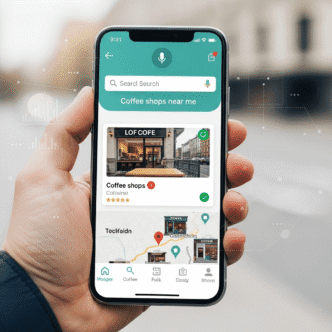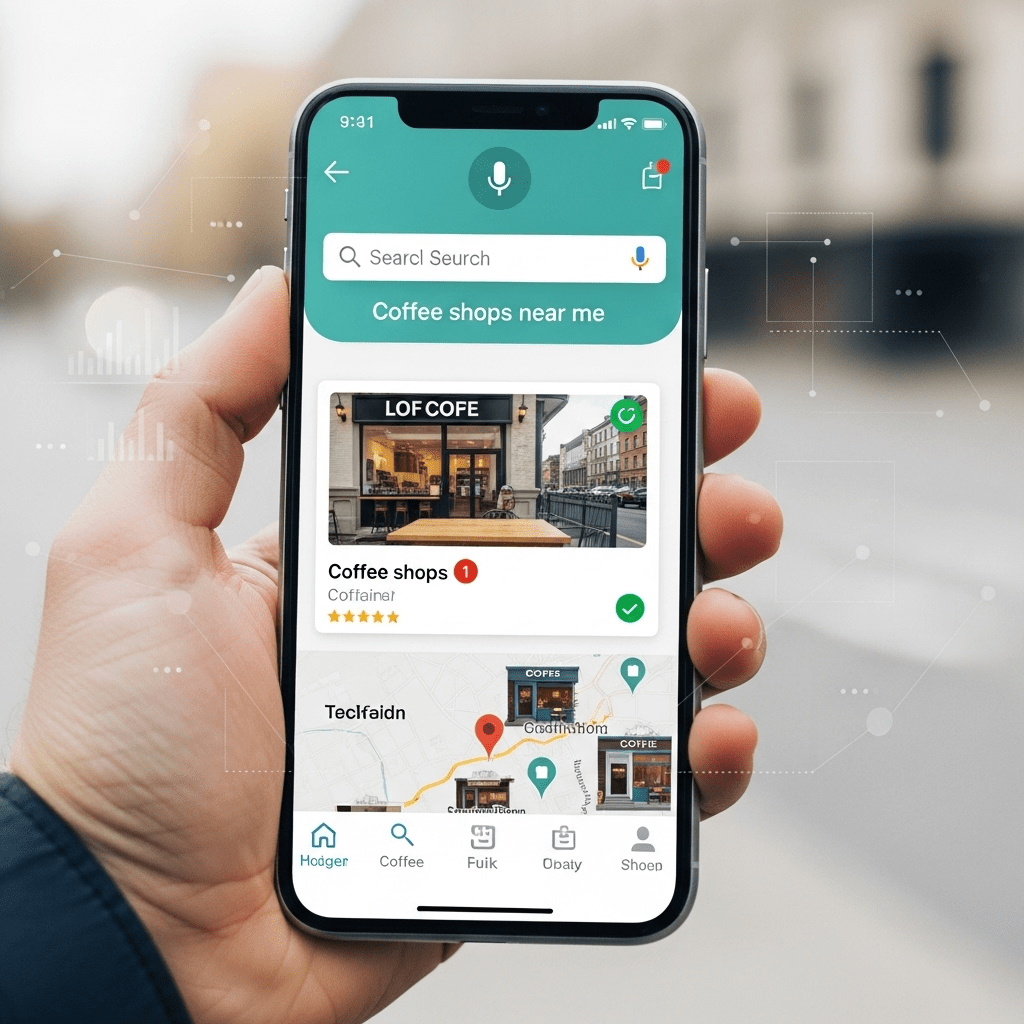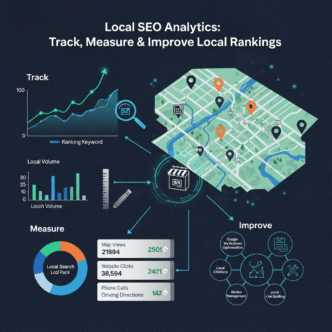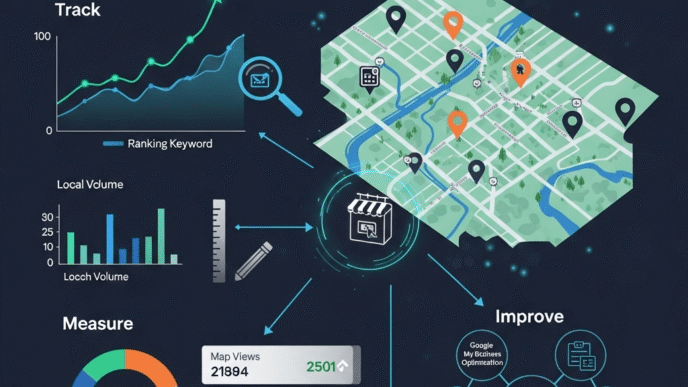Ever asked Siri “find a plumber near me” while water floods your kitchen, only to get results for plumbers three towns over? Or watched potential customers ask Alexa for your service category and heard her recommend your competitor instead?
Here’s what’s happening: 58% of consumers use voice search to find local business information, “near me” searches have grown 900% in two years, and voice queries now account for 27% of all mobile searches globally. Yet most local businesses optimize for typed searches while voice searchers—who have the highest commercial intent—walk past their door to competitors who understand voice search optimization local.
Voice search optimization local isn’t just SEO with a microphone. When someone types “best Italian restaurant Chicago,” they’re researching. When they say “Hey Google, Italian restaurant near me open now,” they’re hungry, nearby, and ready to visit in the next 30 minutes. Different intent demands different optimization.
The conversational nature of voice queries, the mobile context, the expectation of immediate answers, and the zero-click results format mean traditional local SEO tactics fail for mobile voice search. You need featured snippets, natural language content, FAQ optimization, schema markup, and mobile-first everything.
This guide reveals exactly how to optimize for “near me” searches, the proven voice search optimization strategies for local business, techniques for ranking for “near me” keywords, and specific tactics for Siri Alexa Google Assistant optimization that actually drive foot traffic.
Let’s capture the customers who are literally speaking your name—or should be.
Table of Contents
ToggleWhat Makes Voice Search Different from Typed Search?
Voice search SEO requires understanding how people speak differently than they type. These behavioral differences change everything about optimization strategy.
How Do Voice Queries Differ from Typed Queries?
Length differences:
- Typed: “plumber chicago” (2 words)
- Voice: “Hey Google, where can I find a good plumber near me?” (11 words)
Voice queries are 3-5x longer because speaking feels natural and requires less effort than typing on mobile keyboards.
Conversational tone:
- Typed: “weather forecast”
- Voice: “what’s the weather going to be like today?”
Voice uses complete sentences with articles (the, a, an) and natural phrasing.
Question format:
- Typed: “open restaurants”
- Voice: “what restaurants are open near me right now?”
Voice queries are often phrased as questions: who, what, where, when, why, how.
Local intent:
- Typed: can be informational, navigational, transactional
- Voice: heavily skewed toward local “near me” intent (58% of voice searches have local intent)
Real-time context:
- Typed: often planning-oriented
- Voice: immediate need (“open now,” “closest,” “fastest”)
“Voice search optimization isn’t about keywords anymore—it’s about answering questions in natural language the moment someone asks. The businesses winning voice search sound like helpful humans, not SEO robots.” — Purna Virji, Senior Manager of Global Engagement, Microsoft
Understanding how conversational search optimization differs from traditional SEO is critical for comprehensive local SEO strategy.
How Do You Optimize for “Near Me” Searches?
“Near me” search optimization captures the highest-intent local searchers—people literally looking for businesses they can visit immediately.
What Exactly Are “Near Me” Searches?
“Near me” searches include explicit phrases like:
- “coffee shop near me”
- “plumber near me open now”
- “restaurants near me”
But also implicit local intent without “near me”:
- emergency dentist” (Google knows they want local)
- “pizza delivery” (must be nearby)
- “car wash” (local service)
Google’s algorithm recognizes local intent even without location keywords and serves results based on searcher’s device location.
How Does Google Determine “Near Me” Rankings?
Primary factors:
Proximity: Physical distance from searcher is #1 factor. You can’t fake being closer.
Relevance: Your business category, services, and content must match the query.
Prominence: Reviews, ratings, citations, and backlinks signal authority.
Mobile optimization: Voice searches happen on mobile. Slow mobile sites lose.
Google Business Profile completeness: Incomplete profiles get filtered out.
Business hours: “Open now” queries filter closed businesses immediately.
What’s the Strategy for Ranking for “Near Me” Keywords?
Step 1: Optimize your Google Business Profile completely
This is 80% of “near me” optimization. Complete every section:
- Accurate category selection
- Complete address and service areas
- Correct hours (updated for holidays)
- Photos of location, products, team
- Regular Google Posts
- Reviews and responses
Step 2: Mobile-first website optimization
“Near me” searches are 95%+ mobile. Your site must:
- Load in under 3 seconds on mobile
- Use responsive design
- Have click-to-call buttons prominently
- Display address and directions clearly
- Work perfectly on small screens
Step 3: Use natural local language
Don’t write “near me” in your content (awkward). Instead:
- “Serving [neighborhoods] and surrounding areas”
- “Local plumber in [city]”
- “We’re located in [specific area]”
Step 4: Claim all map listings
Ensure you’re on:
- Google Maps
- Apple Maps
- Bing Maps
- Waze
Step 5: Get reviews mentioning location
Encourage reviews that naturally mention your location: “Great coffee shop in Lincoln Park” beats “Great coffee shop.”
Pro Tip: Add “near [landmark]” phrases to your content naturally. Our bakery near Wrigley Field” helps Google understand your proximity to popular landmarks people search for.
Real-World Example:
Mike’s Auto Repair in Portland wasn’t ranking for “auto repair near me” despite being optimized for “auto repair Portland.” He made three changes: optimized GBP with precise location coordinates, added mobile click-to-call buttons, and included natural proximity phrases (“located near Powell’s Books in downtown Portland”). Within 60 days, “near me” traffic increased 340% and 73% converted to calls.
How Do You Optimize Content for Voice Search?
Voice search optimization strategies for local business require writing for ears, not eyes. Content must sound natural when spoken aloud.
What Content Format Works Best for Voice Search?
Featured snippet-friendly formatting:
Voice assistants pull answers from featured snippets (position zero). Format content to win these:
Question + direct answer format:
What are your business hours?
We're open Monday-Friday 9am-6pm, Saturday 10am-4pm, and closed Sunday.
List format:
What services do you offer?
We offer:
- Drain cleaning
- Water heater repair
- Emergency plumbing
- Bathroom remodeling
Table format:
Service | Price
Drain Cleaning | Starting at $150
Water Heater Repair | Starting at $200
Paragraph format (40-60 words):
How much does plumbing repair cost?
Most plumbing repairs in Chicago cost between $150-400 depending on the issue. Simple drain cleaning typically runs $150-200, while water heater repairs start at $200 and can go up to $800 for major fixes. We provide free estimates before starting any work.
Should You Create FAQ Pages for Voice Search?
Absolutely. FAQ pages are voice search gold because they naturally match question-based voice queries.
FAQ best practices:
Use actual questions customers ask:
- Check Google’s “People Also Ask”
- Review customer emails/calls
- Look at search console queries
- Ask your staff what customers commonly ask
Answer in conversational language:
Bad: “Service area: 20-mile radius from downtown” Good: “We serve all of Chicago and surrounding suburbs within about 20 miles, including Evanston, Oak Park, and Skokie.”
Keep answers concise: 40-60 words hits the sweet spot for voice responses.
Use schema markup: FAQPage schema helps Google understand and potentially feature your Q&As.
Real-World Example:
Dr. Lisa’s dental practice created a comprehensive FAQ page with 30 questions patients commonly asked, formatted for featured snippets. Within 90 days, she appeared in position zero for 12 question-based voice queries. Voice-driven appointment requests increased 85%.
How Do Different Voice Assistants Impact Local SEO?
Siri Alexa Google Assistant optimization requires understanding platform differences. Each assistant pulls data from different sources and prioritizes different signals.
Where Do Voice Assistants Get Local Business Information?
| Assistant | Primary Data Source | Optimization Priority |
|---|---|---|
| Google Assistant | Google Search, Google Maps, Google Business Profile | Optimize GBP, Google rankings |
| Siri | Apple Maps, Yelp, other sources | Claim Apple Maps listing, optimize Yelp |
| Alexa | Bing, Yelp, Yext | Optimize Bing Places, Yelp, Yext |
| Cortana | Bing, Bing Places | Bing Places for Business |
How Do You Optimize for Google Assistant?
Google Assistant dominates with 93% market share on Android and growing iOS usage. Optimize local business for voice search on Google by:
Complete Google Business Profile: This is your primary data source for Google Assistant. Every field complete.
Google Maps presence: Ensure accurate pins, hours, photos, and category.
Featured snippets: Structure content to win position zero.
Mobile speed: Google Assistant users are mobile. Fast sites win.
Structured data: LocalBusiness schema helps Google understand your business details.
How Do You Optimize for Siri?
Siri pulls from Apple Maps and Yelp primarily:
Claim Apple Business Connect: Register at business.apple.com
Optimize Yelp completely: Photos, complete info, reviews, responses
Maintain NAP consistency: Apple aggregates from multiple sources; consistency matters
Mobile site quality: Siri users are 100% iOS/mobile
How Do You Optimize for Alexa?
Alexa uses Bing and Yext data:
Claim Bing Places for Business: As important for Alexa as Google is for Assistant
Yext profile: Alexa has partnership with Yext; complete presence there helps
Yelp optimization: Alexa also pulls Yelp data for recommendations
Pro Tip: Focus on Google optimization first (largest market share), then Apple Maps/Yelp (Siri), then Bing/Yext (Alexa). Don’t spread yourself too thin trying to optimize everywhere simultaneously.
What Schema Markup Helps Voice Search Rankings?
Structured data helps voice assistants understand and speak your business information accurately.
What Schema Types Matter for Local Voice Search?
LocalBusiness schema (required):
{
"@context": "https://schema.org",
"@type": "LocalBusiness",
"name": "Your Business Name",
"address": {
"@type": "PostalAddress",
"streetAddress": "123 Main St",
"addressLocality": "Chicago",
"addressRegion": "IL",
"postalCode": "60614"
},
"telephone": "+1-555-123-4567",
"openingHours": "Mo-Fr 09:00-18:00"
}
FAQPage schema (highly valuable): Marks up your FAQ content so voice assistants can extract Q&A pairs directly.
Speakable schema (emerging): Identifies sections of content optimized for text-to-speech, though adoption is still limited.
HowTo schema: For businesses providing how-to guidance, this helps voice assistants read step-by-step instructions.
Validate all schema with Google’s Rich Results Test.
How Do You Track Voice Search Performance?
Voice search traffic is notoriously hard to isolate in analytics since it looks like organic mobile traffic.
What Metrics Indicate Voice Search Success?
Indirect indicators:
Mobile traffic increases: Since voice is primarily mobile, growing mobile traffic often includes voice
Featured snippet appearances: Google Search Console shows position zero rankings
Question-based keyword rankings: Track rankings for “how,” “what,” “where,” “when” queries
“Near me” keyword rankings: Monitor specifically using rank trackers with mobile location settings
Direct traffic spikes: Voice searchers often click featured snippets, which sometimes appear as direct traffic
Phone calls from mobile: Voice searchers are 3x more likely to call than click
Google Business Profile insights: Track “search queries” in GBP for question-based terms
What Tools Help Monitor Voice Search?
Google Search Console: Free; shows queries driving traffic, including question-based voice queries
SEMrush/Ahrefs: Track featured snippets you own and could target
AnswerThePublic: Discover question-based queries in your niche
Google Business Profile insights: See how people find your business
Call tracking: Numbers like CallRail attribute calls to source, including likely voice searches
For comprehensive tracking integrated with your complete local SEO strategy, use tools that specifically track mobile and local performance.
What Are Voice Search Optimization Best Practices for 2025?
The landscape evolves quickly. Stay ahead with current best practices.
What’s Working Now?
Conversational, natural content: Write like you talk. Read content aloud; if it sounds robotic, rewrite.
Question targeting: Every service page should answer 3-5 common questions about that service.
Local landing pages: Neighborhood-specific pages capture hyper-local voice searches.
Fast mobile sites: Under 3 seconds load time is table stakes.
Complete business info everywhere: GBP, Apple Maps, Bing—everywhere consistently.
Active review generation: Fresh reviews improve all local rankings including voice.
Pro Tip: Record yourself explaining your services out loud to customers. Transcribe it. That’s how your website content should sound—natural, helpful, conversational. It’s perfect for voice search.
Final Thoughts: Your Voice Search Optimization Action Plan
Voice search optimization local isn’t future-proofing—it’s present-day necessity. With 27% of mobile searches now voice-driven and “near me” queries growing 900%, ignoring voice means ignoring a quarter of your potential customers.
Your 30-day action plan:
Week 1: Audit and complete Google Business Profile 100%. Add hours, photos, posts, services, and answer all questions in Q&A section.
Week 2: Create/expand FAQ page with 15-20 common customer questions answered conversationally in 40-60 words each.
Week 3: Optimize top 5 pages for featured snippets using question+answer format. Test mobile site speed and fix slowdowns.
Week 4: Implement LocalBusiness and FAQPage schema. Claim Apple Maps and Bing Places listings.
Ongoing: Add one FAQ monthly. Monitor featured snippet opportunities. Track mobile traffic and conversion rates.
The businesses dominating voice search aren’t using secret tactics—they’re speaking their customers’ language, literally. When someone asks their phone a question, you want to be the answer.
Frequently Asked Questions About Voice Search Optimization
How do I rank for voice search if I don’t rank in regular search?
Voice search pulls heavily from featured snippets (position zero), which you can win even without ranking #1. Focus on answering specific questions better than anyone else with concise, clear answers in the 40-60 word range. FAQ pages and question-targeted content can help you win featured snippets even if your overall domain authority is lower than competitors.
Do I need to write “near me” in my website content?
No, and you shouldn’t—it reads awkwardly. Google understands local intent without you writing “near me.” Instead, use natural location references: “serving downtown Chicago and surrounding neighborhoods,” “located on Main Street in Lincoln Park,” or “we’re your local plumber in the Austin area.” Focus on optimizing your Google Business Profile, which is what actually ranks for “near me” queries.
What’s the ideal content length for voice search answers?
Voice assistants typically read 29-40 words for direct answers. For featured snippets, aim for 40-60 words—enough to fully answer the question but concise enough to be spoken naturally. Longer explanations should follow the brief answer for users who want more detail, but lead with the concise version voice assistants prefer.
How important are reviews for voice search rankings?
Extremely important. Voice assistants prioritize businesses with high ratings and recent reviews when recommending options. Google Assistant often verbally mentions star ratings when suggesting businesses. Focus on maintaining 4.5+ stars with steady review velocity (2-4 new reviews monthly). Respond to all reviews to show engagement.
Does voice search work differently in different languages?
Yes, significantly. English voice search is most advanced, but Spanish, Chinese, and other major languages have different optimization nuances. Focus on natural language in the target language, cultural question phrasing differences, and local dialect variations. If serving bilingual communities, create content in both languages optimized for how each language’s speakers naturally ask questions.
Should I optimize for smart speakers (Alexa, Google Home) differently than mobile voice?
Smart speakers primarily handle informational queries (“what time does store close”) while mobile voice search drives action (“navigate to store”). Optimize for both: FAQ content for smart speakers, clickable phone numbers and directions for mobile. Google Business Profile handles mobile voice while featured snippets serve smart speakers.
How do I track if voice search is sending me traffic?
Voice traffic appears as mobile organic traffic in analytics, making it hard to isolate. Indicators include: increased mobile traffic without corresponding desktop increases, traffic from question-based keywords (check Search Console), phone calls during business hours (voice searchers call 3x more), and Google Business Profile “phone call” actions increasing. Use call tracking to attribute calls to likely voice sources.
Can voice search help my business if I don’t have a physical location?
Yes, for service area businesses. Optimize for implicit local intent keywords (“emergency plumber,” “laptop repair”) and service+location combinations (“plumber serving Austin”). Your Google Business Profile can hide your address while showing service areas. Voice searchers looking for mobile services use voice search at high rates.
What’s the biggest voice search mistake businesses make?
Writing robotic, keyword-stuffed content that sounds unnatural when spoken aloud. Voice search rewards conversational, helpful content. Read your content aloud—if it sounds like a robot or a spam email, rewrite it. The second-biggest mistake is neglecting Google Business Profile, which is the primary data source for local voice results.
How will AI assistants change voice search optimization?
AI assistants like ChatGPT integrated into search are making voice interactions more conversational and contextual. Future optimization will focus even more on: providing comprehensive, accurate information (AI checks facts across sources), structured data helping AI understand context, content that directly answers complex questions, and maintaining consistent business information across platforms AI assistants scrape.
For comprehensive implementation of voice search within your complete local SEO ecosystem, explore our local SEO mastery guide.
Voice Search Optimization Dashboard 2025
Analytics & Strategy for "Near Me" and Voice Search Rankings
Voice vs Typed Search Behavior
Voice Search Intent
Voice searches are 3-5x longer, 95% mobile, and have 3x higher local intent than typed searches. Optimizing for natural language questions is critical.
Voice Assistant Market Share
Voice Search Optimization Priority Matrix
| Assistant | Market Share | Data Source | Priority |
|---|---|---|---|
| Google Assistant | 93% | Google Maps, GBP | Critical |
| Siri | 5% | Apple Maps, Yelp | High |
| Alexa | 2% | Bing, Yext | Medium |
Featured Snippet Impact on Voice
Related posts:
- Voice Search Optimization for Smart Assistants: Alexa, Siri, Google Assistant Strategy
- What is Voice Search SEO? Understanding Voice Search Optimization Fundamentals
- Google Assistant SEO: Voice Search Optimization for Android & Google Home
- Multi-Location SEO Strategy: Rank Multiple Business Locations in 2025














